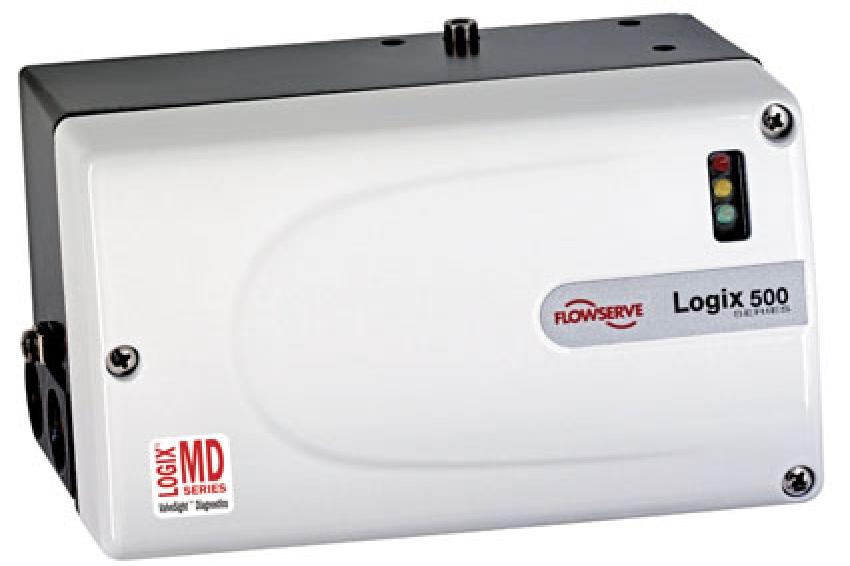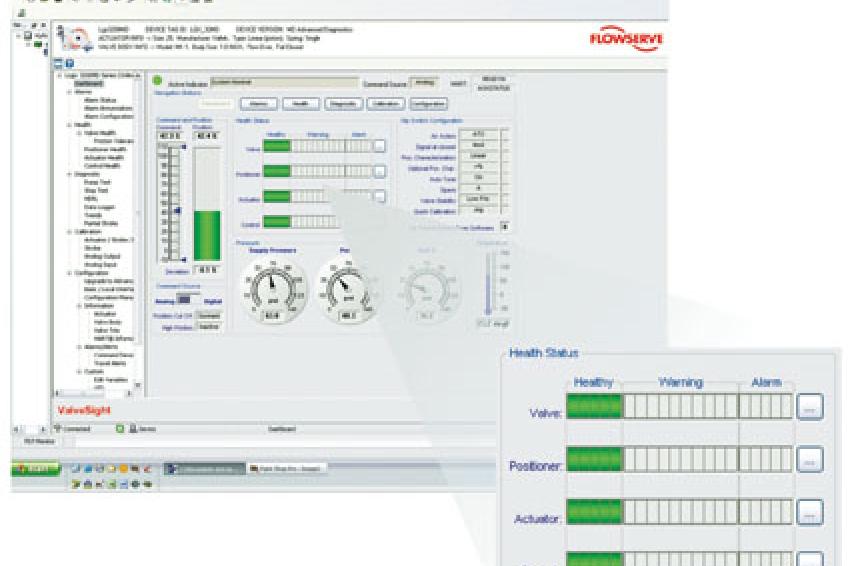Preventive Maintenance
Regulating Valves: Avoid Errors Before Symptoms Occur
Safeguard - Preventive maintenance strategies for critical components within a production plant or production process improve the throughput rate and reduce costs, without abandoning or jeopardizing safety requirements, reliability and environmental regulations. Regulating valves are components that can have a significant effect on process reliability, operational life and maintenance costs if they are not serviced properly. Measuring the actual state of these regulating valves in the process, however, requires complex analyses. Valvesight from Flowserve is able to achieve this goal due to the integration of a diagnostic system, regulating valve and digital position controller.
Valvesight is an innovative, network-capable diagnostic system for Windows, developed by Flowserve for regulating valves; the system can be integrated seamlessly in a local control station and/or in a plant asset management system via FDT/DTM. The goal of asset management is an effective maintenance and repair process for critical plant components, to ensure optimum utilization. The core of Valvesight is the intelligent diagnostic system, which constantly monitors valve, drive, position controller and control and regulating signals. If, for example, certain indicators or behavior patterns occur, as an advance indication of potential problems, they are identified by the system in a traceable manner.
Digital Position Controllers
The intelligence required in the field is integrated in the respective digital position controller. In principle, two models are available: the normal position controller of the Logix 520MD series and the explosion proof controller of the Logix 3200MD series, where the number two indicates HART communication capability. Two Valvesight versions are available within this new generation of digital position controllers. The freeware basic version for the Logix variants 520MD and 3200MD allows configuration of the position controller. The stroke and path counter and the journey meter - but not the pressure sensors - provide the corresponding input for basic tests within the scope of the diagnosis. The Logix 521MD and Logix 3210MD versions, on the other hand, feature advanced diagnosis capabilities with the inclusion of pressure sensors. The paid version of Valvesight for the Logix position controllers 522MD and 3220MD is equipped to full capacity for complete diagnostic calibration and online diagnosis.
Longer valve life, prevention or reduction of failures, down-times and replacement parts result in substantially lower operating costs. These make up a major part of the life-cycle costs, but since they are difficult to quantify compared with investment considerations at the time of procurement, they receive less attention. Valvesight offers numerous possibilities for profitability improvement. Early and precise localization of malfunctions before they occur reduces the number and frequency of unscheduled interruptions, for an optimum mean time between failures (MTBF). The system also reduces the mean time to repair (MTTR) by providing instructions for correct maintenance procedures by preparing a turnaround in which activities are assigned priorities, so only "defective" or endangered parts are serviced. This concentration of maintenance activities on specific units reduces the workload and the related costs. Statistics of Flowserve customers have shown that up to 40 % of regular maintenance passes (turnaround) resulted in a report with "no defects". Such inefficient maintenance passes are eliminated by use of the diagnostic software, giving maintenance personnel more time for actually needed maintenance or repairs.
Discovery of Irregularities in the Internal Process
The new feature of this fully automatic diagnostic system is that it does not point out symptoms - which generally have different causes - but instead offers a foresighted, preventive diagnosis. For example, a description of a problem could point out the symptom that a particular valve is running more slowly. But for correct intervention and elimination of the problem, the critical question is: Why is the valve running slowly? The symptom does not provide information on the actual cause of the problem. Various reasons could be responsible. This demonstrates one of the biggest advantages of Valvesight. Since all parameters are permanently recorded, problems can be identified early on as irregularities and located based on the specific knowledge of the respective valve type. This allows maintenance personal to start working right away with the right equipment or toolbox, since they have access to all data via the dashboard or graphical user interface.
Essentially, plant operators and designers enjoy the following advantages:
Exact analysis of the status of the valve. The focus is on the status of the valve and not on alarm signals. Alarms can be misleading and usually leave room for interpretation;
Analyses focus on "why" and not on "what";
Intelligible suggestions are made for the required action to keep the valve and the entire production process functioning longer; and
Productivity is increased by lowering the costs of conventional corrective maintenance, repairs, downtimes and setup and lead times.
Fast And User-friendly Operation
Valvesight is user-friendly and designed for use by the operator at the control station, product management, maintenance and service personnel, as well as the plant designer. No special detailed knowledge of integrated regulating valves or the analysis of complicated diagnostic data is needed. The system operates on the basis of the "open standard"; due to compatibility with the FDT/DTM standard, it can be integrated in existing control stations and even retrofitted for regulating valves that are already installed. The forerunner versions of the new Logix position controllers already in service can be easily upgraded to Valvesight Communication. This enables configuration, parameterization and calibration, if not online, at least via DTM, so the basic functions are available. While other manufacturers of diagnostic software reserve the ownership of their data, Valvesight gives the user all the required information. The diagnostic algorithms and recommendations embody the entire Flowserve expertise on regulating valves. Users of valves or drive systems from other manufacturers can also take advantage of the features of Valvesight. For this purpose, the digital position controller can be easily installed on the third-party equipment.
Complex information is communicated quickly and easily via a specially developed interface, similar to a control station, which does not require allocation of the alarms by the user to identify the "health" status of valves, drive systems or position controllers. The status bar display gives the user a clear overview of the four key status indicators: valve, drive, position controller and control signal. The colors and lengths of these bars represent the current process situation. Green stands for "Everything OK", yellow for "Caution or Warning" and red for "Alarm"; the length of the bar represents the degree or level of the assessment. Logs of all critical data are archived and can be retrieved as needed.
Increased Process Reliability and Profitability
The analysis results point to causes of interference and provide information on eliminating them, so that maintenance and repairs focus on actual critical situations. Available software tools, detailed online help and manuals speed up configuration and setup, as well as maintenance processes and repairs. With minimal instruction, every user can quickly start using Valvesight and implement the advantages of a strategy for preventive maintenance in the control station and asset management system.
Initial installations in the Netherlands have met not only with wide acceptance but also with general acclaim, due to the increased process reliability and substantial savings potential. The higher efficiency in maintenance and repairs as a result of reduced downtimes and replacement parts has a direct effect on the reduction of operating costs and process optimization, resulting in a considerable overall increase in productivity.







